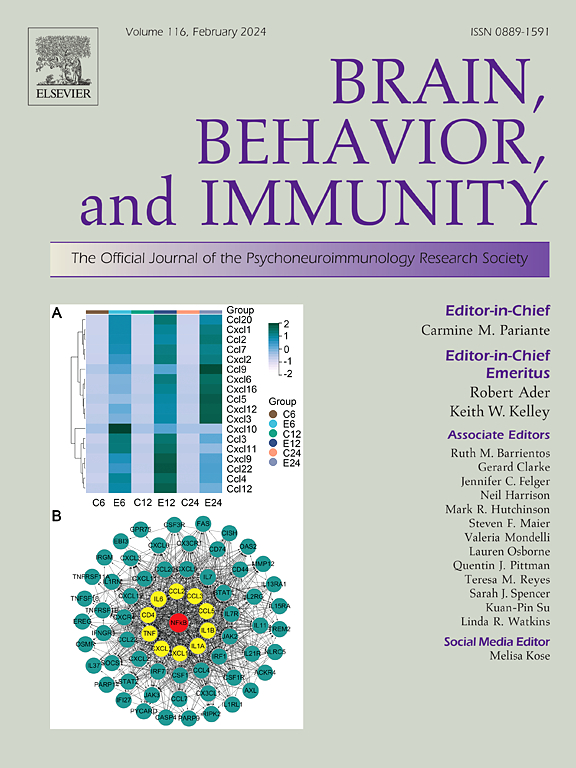反复左旋多巴(L-DOPA)对重度炎症抑郁症患者奖赏回路、努力动机和快感缺乏的持续影响
IF 8.8
2区 医学
Q1 IMMUNOLOGY
引用次数: 0
摘要
炎症生物标志物如c反应蛋白(CRP)在一部分抑郁症患者中升高,并与腹侧纹状体(VS)到腹内侧前额叶皮层(vmPFC)奖励回路的低功能连通性(FC)和快感缺乏症状相关。将这些关系与炎症对多巴胺的影响联系起来的证据与我们最近的发现一致,即急性左旋多巴(L- dopa)增加VS-vmPFC FC与高但不低CRP的抑郁症患者死亡的快感缺乏症相关(bbb2.0 vs ≤ 2 mg/L)。为了确定反复服用左旋多巴是否会对这些患者的FC和行为产生持续的影响,医学上稳定的CRP > 2mg /L和缺乏症(n = 18)的门诊抑郁症患者按随机顺序接受一周三剂量的左旋多巴(150-450 mg/天/周加卡比多巴)或安慰剂。静息状态(rs)和任务型(tb);在基线和安慰剂及每次剂量的左旋多巴后一周,评估fMRI、努力动机以及快感缺乏症和抑郁严重程度的探索性测量。对不同剂量左旋多巴的反应因结果而异。例如,150和450 mg/天/周的L-DOPA显著增加VS-vmPFC rs-FC (p z = 0.82-0.98,p z = 0.48-0.97,p本文章由计算机程序翻译,如有差异,请以英文原文为准。
Sustained effects of repeated levodopa (L-DOPA) administration on reward circuitry, effort-based motivation, and anhedonia in depressed patients with higher inflammation
Inflammatory biomarkers like C-reactive protein (CRP) are elevated in a subset of patients with depression and have been associated with lower functional connectivity (FC) in a ventral striatum (VS) to ventromedial prefrontal cortex (vmPFC) reward circuit and symptoms of anhedonia. Evidence linking these relationships to the effects of inflammation on dopamine is consistent with our recent findings that acute levodopa (L-DOPA) increased VS-vmPFC FC in association with deceased anhedonia in depressed patients with higher but not lower CRP (>2 versus ≤ 2 mg/L). To determine whether repeated L-DOPA administration caused sustained effects on FC and behavior in these patients, medically stable depressed outpatients with CRP > 2 mg/L and anhedonia (n = 18) received one week of three doses of L-DOPA (150–450 mg/day/week with carbidopa) or placebo in a randomized order. Resting-state (rs) and task-based (tb; monetary incentive delay) fMRI, effort-based motivation, and exploratory measures of anhedonia and depression severity were assessed at baseline and after one week of placebo and each dose of L-DOPA. Responses to individual doses of L-DOPA varied across outcomes. For example, VS-vmPFC rs-FC was significantly increased by L-DOPA at 150 and 450 mg/day/week (p < 0.01), whereby approximately half of patients responded optimally to 150 mg/day L-DOPA and approximately half required higher doses for maximum effect. While effort-based motivation was only significantly increased by L-DOPA at 150 mg/day (p < 0.05), it correlated with VS-vmPFC rs-FC at this dose (r = 0.64, p = 0.024), and all L-DOPA doses met a clinically significant threshold of ≥ 10 % increase versus placebo. When comparing the maximum response at any L-DOPA dose to placebo, high effect sizes were observed for these primary outcomes and tb-FC during reward anticipation (dz = 0.82–0.98, p < 0.01), as well as secondary and exploratory measures of anhedonia and depression severity (dz = 0.48–0.97, p < 0.05). Sustained effects on reward circuitry, effort-based motivation, and anhedonia by repeated L-DOPA administration support the therapeutic potential of agents that increase dopamine in depressed patients with higher inflammation.
求助全文
通过发布文献求助,成功后即可免费获取论文全文。
去求助
来源期刊
CiteScore
29.60
自引率
2.00%
发文量
290
审稿时长
28 days
期刊介绍:
Established in 1987, Brain, Behavior, and Immunity proudly serves as the official journal of the Psychoneuroimmunology Research Society (PNIRS). This pioneering journal is dedicated to publishing peer-reviewed basic, experimental, and clinical studies that explore the intricate interactions among behavioral, neural, endocrine, and immune systems in both humans and animals.
As an international and interdisciplinary platform, Brain, Behavior, and Immunity focuses on original research spanning neuroscience, immunology, integrative physiology, behavioral biology, psychiatry, psychology, and clinical medicine. The journal is inclusive of research conducted at various levels, including molecular, cellular, social, and whole organism perspectives. With a commitment to efficiency, the journal facilitates online submission and review, ensuring timely publication of experimental results. Manuscripts typically undergo peer review and are returned to authors within 30 days of submission. It's worth noting that Brain, Behavior, and Immunity, published eight times a year, does not impose submission fees or page charges, fostering an open and accessible platform for scientific discourse.

 求助内容:
求助内容: 应助结果提醒方式:
应助结果提醒方式:


